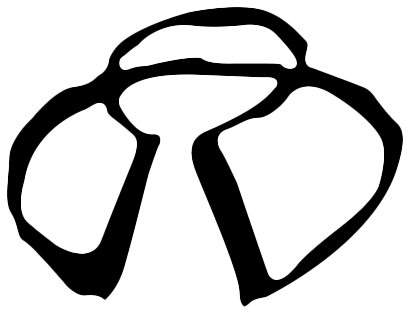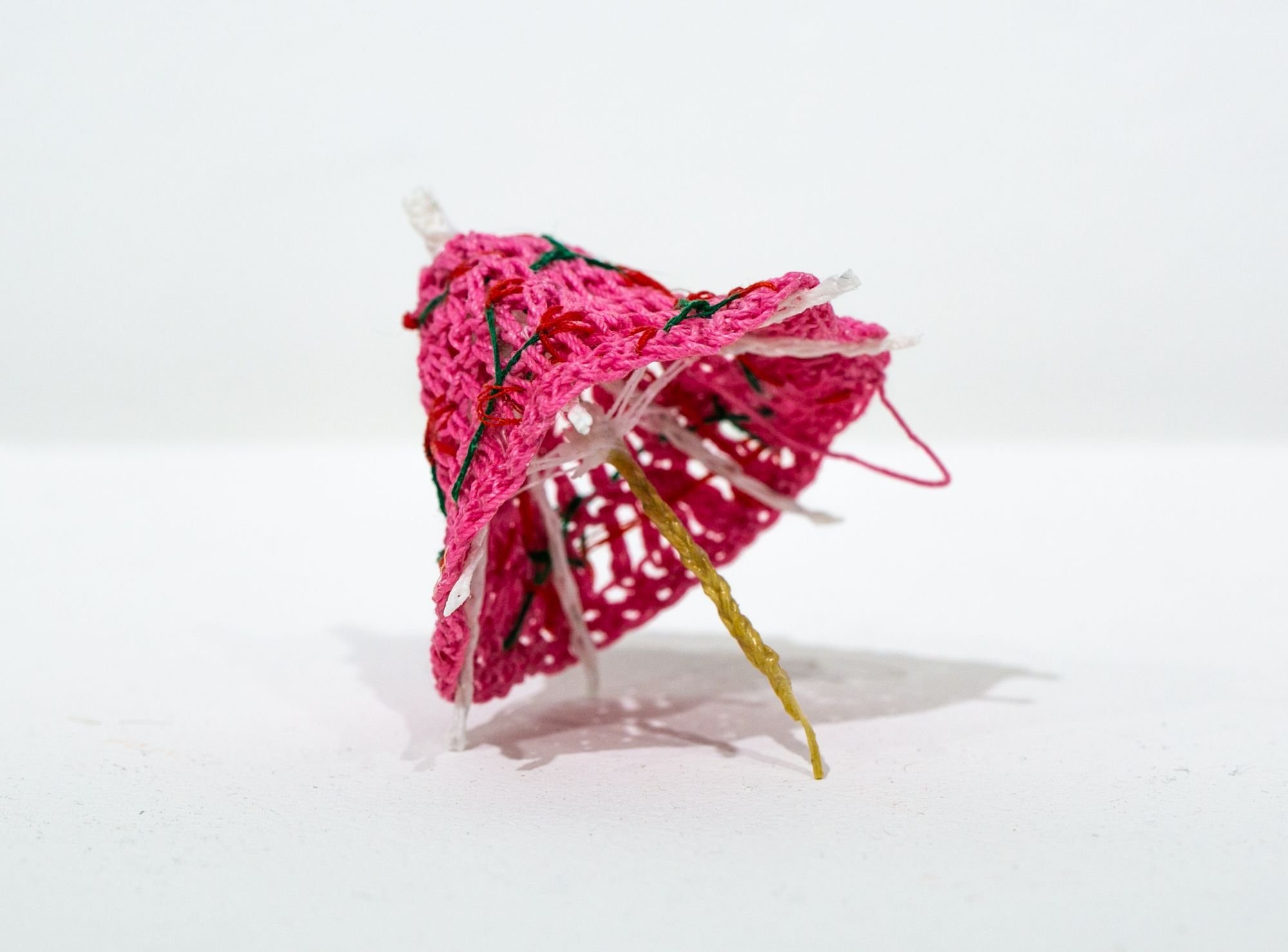Caitlin McCormack, "Sweet One"
Crocheted cotton string, glue. 3.75” H x 3” W x 2.75” 2021.
SHIPPING IS NOT INCLUDED IN PRICE. PLEASE CONTACT INFO@COLLARWORKS.ORG FOR AN ESTIMATE.
BIO
Caitlin McCormack (b. 1988, Plainfield NJ) is a Philadelphia-based fiber artist who has participated in solo and group exhibitions at The Mütter Museum, Museum Rijswijk (NL), Mesa Contemporary Art Museum, The Taubman Museum of Art, Hashimoto Contemporary, The Fort Wayne Museum of Art, Feinkünst Krüger (DEU), Vanilla Gallery (JP), Rhodes Contemporary (UK), Field Projects, MoCA Westport, and SPRING/BREAK Art Show in NYC. Their work has appeared in publications including Juxtapoz, Hyperallergic, Smithsonian, The Guardian, Fiber Art Now, and Bust Magazine, and their sculptures were the subject of an interview with Jim Cotter for Articulate on PBS. In addition to holding teaching positions in Philadelphia at The Pennsylvania Academy of the Fine Arts and Hussian College of Art and Design, McCormack has completed artist residencies at ChaNorth (NY), The Peter Bullough Foundation (VA), and The Wassaic Project (NY). McCormack received a Joseph Robert Foundation grant in 2021.
STATEMENT
My work acknowledges a trans-generational craft tradition and externalizes experiences with self harm, body dysmorphia, and assault, resulting in an intimate archive of objects. Exploring gender, sexuality, isolation, and Anthropocene hamartia through an uncanny lens, these works contemplate societal reluctance to legitimize gendered craft and regard crochet as a behavioral response to apocalyptic conditions. Evoking folklore, sci-fi, and cinematic body horror, each object is a memory’s artifact made viewable from a distance. My self-taught process involves the dredging of crocheted thread in adhesives and foraged pigments. The resultant material is fashioned into sculptural forms. The cotton string central to this process is sourced from garage sales and inheritances from deceased relatives who used it during the Great Depression to create adornments for their homes and bodies. My grandmother taught me how to crochet as a child; the practice is entwined with my compulsion to navigate trauma through craft.
Crocheted cotton string, glue. 3.75” H x 3” W x 2.75” 2021.
SHIPPING IS NOT INCLUDED IN PRICE. PLEASE CONTACT INFO@COLLARWORKS.ORG FOR AN ESTIMATE.
BIO
Caitlin McCormack (b. 1988, Plainfield NJ) is a Philadelphia-based fiber artist who has participated in solo and group exhibitions at The Mütter Museum, Museum Rijswijk (NL), Mesa Contemporary Art Museum, The Taubman Museum of Art, Hashimoto Contemporary, The Fort Wayne Museum of Art, Feinkünst Krüger (DEU), Vanilla Gallery (JP), Rhodes Contemporary (UK), Field Projects, MoCA Westport, and SPRING/BREAK Art Show in NYC. Their work has appeared in publications including Juxtapoz, Hyperallergic, Smithsonian, The Guardian, Fiber Art Now, and Bust Magazine, and their sculptures were the subject of an interview with Jim Cotter for Articulate on PBS. In addition to holding teaching positions in Philadelphia at The Pennsylvania Academy of the Fine Arts and Hussian College of Art and Design, McCormack has completed artist residencies at ChaNorth (NY), The Peter Bullough Foundation (VA), and The Wassaic Project (NY). McCormack received a Joseph Robert Foundation grant in 2021.
STATEMENT
My work acknowledges a trans-generational craft tradition and externalizes experiences with self harm, body dysmorphia, and assault, resulting in an intimate archive of objects. Exploring gender, sexuality, isolation, and Anthropocene hamartia through an uncanny lens, these works contemplate societal reluctance to legitimize gendered craft and regard crochet as a behavioral response to apocalyptic conditions. Evoking folklore, sci-fi, and cinematic body horror, each object is a memory’s artifact made viewable from a distance. My self-taught process involves the dredging of crocheted thread in adhesives and foraged pigments. The resultant material is fashioned into sculptural forms. The cotton string central to this process is sourced from garage sales and inheritances from deceased relatives who used it during the Great Depression to create adornments for their homes and bodies. My grandmother taught me how to crochet as a child; the practice is entwined with my compulsion to navigate trauma through craft.
Crocheted cotton string, glue. 3.75” H x 3” W x 2.75” 2021.
SHIPPING IS NOT INCLUDED IN PRICE. PLEASE CONTACT INFO@COLLARWORKS.ORG FOR AN ESTIMATE.
BIO
Caitlin McCormack (b. 1988, Plainfield NJ) is a Philadelphia-based fiber artist who has participated in solo and group exhibitions at The Mütter Museum, Museum Rijswijk (NL), Mesa Contemporary Art Museum, The Taubman Museum of Art, Hashimoto Contemporary, The Fort Wayne Museum of Art, Feinkünst Krüger (DEU), Vanilla Gallery (JP), Rhodes Contemporary (UK), Field Projects, MoCA Westport, and SPRING/BREAK Art Show in NYC. Their work has appeared in publications including Juxtapoz, Hyperallergic, Smithsonian, The Guardian, Fiber Art Now, and Bust Magazine, and their sculptures were the subject of an interview with Jim Cotter for Articulate on PBS. In addition to holding teaching positions in Philadelphia at The Pennsylvania Academy of the Fine Arts and Hussian College of Art and Design, McCormack has completed artist residencies at ChaNorth (NY), The Peter Bullough Foundation (VA), and The Wassaic Project (NY). McCormack received a Joseph Robert Foundation grant in 2021.
STATEMENT
My work acknowledges a trans-generational craft tradition and externalizes experiences with self harm, body dysmorphia, and assault, resulting in an intimate archive of objects. Exploring gender, sexuality, isolation, and Anthropocene hamartia through an uncanny lens, these works contemplate societal reluctance to legitimize gendered craft and regard crochet as a behavioral response to apocalyptic conditions. Evoking folklore, sci-fi, and cinematic body horror, each object is a memory’s artifact made viewable from a distance. My self-taught process involves the dredging of crocheted thread in adhesives and foraged pigments. The resultant material is fashioned into sculptural forms. The cotton string central to this process is sourced from garage sales and inheritances from deceased relatives who used it during the Great Depression to create adornments for their homes and bodies. My grandmother taught me how to crochet as a child; the practice is entwined with my compulsion to navigate trauma through craft.

